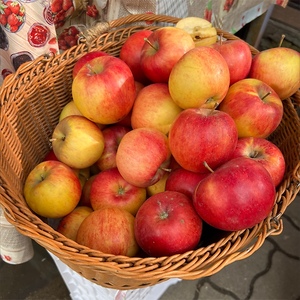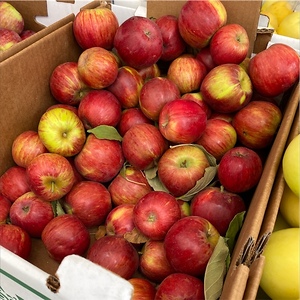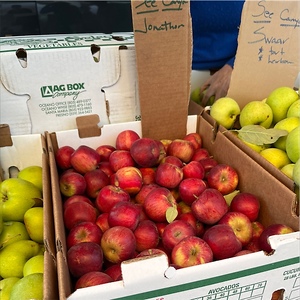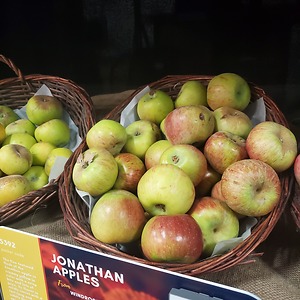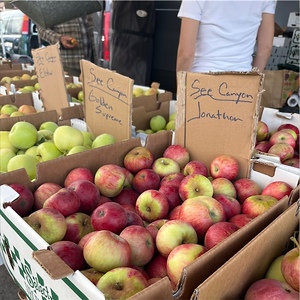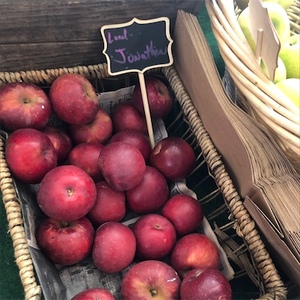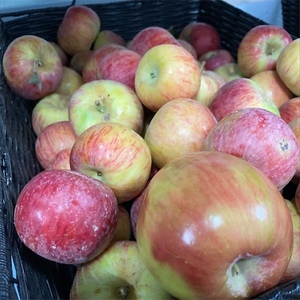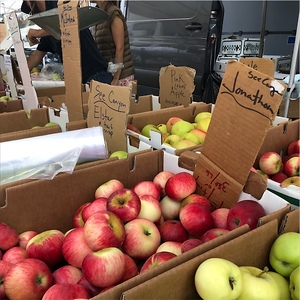


Jonathan Apples
Estimated Inventory, 72 ct : 0
Description/Taste
Jonathan apples are a small to medium-sized varietal, averaging 180 to 200 grams in weight, and have a round, oblong, to conical shape with subtly ribbed, flat shoulders, a curved, broad center, and a narrow, flat base. The variety often has an elongated nature, and the stems are dark brown, woody, and fibrous, connecting into an open, somewhat rounded cavity. The apple’s skin is thin but tough and has a smooth, taut, and glossy nature, developing a layer of wax when ripe. The skin also features a yellow-green base, almost entirely covered in a dark red to crimson blush. Some Jonathan apples will have a solid blush, while others feature broken striping, a characteristic developed based on sun exposure. The apples also sometimes form a green-brown, textured russet with raised lenticels scattered across the surface. Underneath the skin, the ivory to yellow flesh is fine-grained, aqueous, and dense, especially known for its juice, and has a soft, crisp, and succulent consistency. The flesh also encases a small central core filled with tiny black-brown seeds. When ripe, Jonathan apples release a fragrant, fruity aroma and should feel heavy for their size, indicating high juice content. The variety also contains sugar mixed with acidity, creating a refreshing, sprightly, sweet, sour, and tangy taste with faint spice-like nuances. Jonathan apples harvested early in the season will be more tart, while fruits picked at the end of the season will be sweeter.
Seasons/Availability
Jonathan apples are harvested in the mid-fall through mid-winter and can be stored through the late spring.
Current Facts
Jonathan apples, botanically classified as Malus domestica, are an American variety belonging to the Rosaceae family. The mid-season cultivar is an heirloom apple discovered in New York in the 19th century and grows on trees reaching 4 to 6 meters in height. Jonathan apples are known for their sprightly, sweet, and tart flavoring, vibrant coloring, and fine-grained, juicy flesh. Since their discovery, Jonathan apples were once a famous commercial cultivar, but over time, they faded from popularity as newer, modern varieties have replaced them in retail markets. The cultivar has remained a specialty heirloom in the northeastern United States, grown as a delicacy for fresh eating and baked goods. Jonathan apples are also famously used in breeding programs and have contributed to the creation of other varieties, including Jonagold, Jonafree, and Jonamac.
Nutritional Value
Jonathan apples are a source of copper to develop connective tissues, magnesium to control nerves, calcium to build strong bones and teeth, and vitamin E to reduce inflammation. The variety also provides fiber to regulate the digestive tract, vitamin C to strengthen the immune system, vitamin A to maintain healthy organ functioning, potassium to balance fluid levels within the body, and other nutrients, including iron, vitamin K, and zinc. The apple's pigmented skin contains anthocyanins, natural compounds with antioxidant-like properties that protect the cells against free radical damage.
Applications
Jonathan apples have a sweet and sour flavor suited for fresh and cooked preparations. The variety is popularly consumed straight out of hand and is sometimes chilled for a few hours before eating to enhance the flavor. Jonathan apples can also be incorporated into salads, served on cheese boards with dried fruits and nuts, or mixed into fruit salads as a side dish. Try layering Jonathan apples into parfaits as a crunchy, juicy addition. The apples can also be sliced and dipped into various spreads and nut butter as a bite-sized snack. In addition to fresh preparations, Jonathan apples are simmered into jams, jellies, apple butter, and applesauce, and the soft sauce is often served with roasted meats as a savory-sweet dish. Jonathan apples can also be baked into pies, cakes, and muffins or incorporated into crisps, cobblers, dumplings, and fritters. In the northeastern United States, Jonathan apples are pressed into juice and are a favored apple for cidermaking, or the peels are dried and steeped as tea. The apples are also seasonally dipped whole into melted sugar or caramel as a candied apple. In pies, it is recommended to combine Jonathan apples with firmer varieties that hold their shape, such as Fuji or Granny Smith apples. Whole, unwashed Jonathan apples pair well with herbs such as parsley, mint, basil, and rosemary, spices including cinnamon, ginger, cardamom, and cloves, and cheeses such as goat, blue, brie, and cheddar. Whole, unwashed Jonathan apples will keep for 1 to 2 months when stored in a cool, dry, and dark location, such as a cellar or the refrigerator’s crisper drawer. The apples may be able to be stored for more extended periods, but they tend to lose their tartness and crispness over time. When stored in the fridge, it is recommended to wrap the fruits in newspaper and store them in a plastic bag to prevent the apples from drying. The variety can also be frozen for extended use and added to cooked preparations.
Ethnic/Cultural Info
Jonathan apples have been known by several names throughout history. The variety has been called New Esopus Spitzenburg and New Spitzenburg, named after its rumored parentage, and it has been known as Ulster Seedling, given in honor of the apple’s home county in New York. Most of these names are now rarely used, but there is still some debate about how the variety acquired its Jonathan moniker. One story claims that a lady named Rachel Negus Higley named Jonathan apples. Mrs. Higley obtained apple seeds from a cider mill in Connecticut and carried the seeds to Ohio, where she and her husband established a homestead in 1796. It is said Mrs. Higley cared for the apple trees and eventually named them Jonathan, either after her husband or a young boy who would frequently visit her orchard. The second story recounts a farmer named Philip Rick who discovered the chance seedling on his farm in Woodstock in Ulster County, New York. The apples were initially called Rick apples but were given their Jonathan descriptor when farmer Rick’s friend Jonathan Hasbrouck presented the apple variety to Judge Jesse Buel, president of the Albany Horticultural Society. Legend has it that Judge Buel, who was close friends with Jonathan Hasbrouck, renamed Rick apples to Jonathan, and the name stuck, establishing the variety under its famous moniker.
Geography/History
Jonathan apples are native to the United States and were discovered in the northeast. There are two theories behind the apple’s origins, tracing it to either Connecticut or New York, but the most agreed-upon theory connects the apple to the farm of Philip Rick in Woodstock, a town in Ulster County, New York. Jonathan apples are thought to be a seedling of Esopus Spitzenburg apples, discovered sometime in the late 18th to early 19th centuries. The variety was presented to the Albany Horticultural Society by lawyer Jonathan Hasbrouck in 1826, and the society's president, Judge Jesse Buel, personally advocated for the new apple through written publications. Judge Buel was an agriculturalist who dedicated much of his life to an 85-acre farm near Albany. He first wrote about Jonathan apples in a message sent to the New York Horticultural Society in 1826, and the variety was featured on a list of the most valuable apples propagated in New York State. Judge Buel also sent the apples to the Horticultural Society of Massachusetts in 1829 and the Horticultural Society of London in 1831. By the end of the 19th century, Jonathan apples had been successfully introduced and established as a popular commercial cultivar. The variety was grown in home gardens and commercial orchards, but over time, modern varieties overshadowed the apples, leading them to disappear from commercial production. Today, Jonathan apples are not commercially produced and are only grown in small quantities in the United States as a specialty apple. The variety was also introduced to Japan in 1871 through the Hokkaido Development Commission, as select western apples were chosen to increase cultivation and breeding programs within the country. In Japan, Jonathan apples are known as Kogyoku apples. When in season, Jonathan apples are found throughout the Northeast, Midwest, and Pacific Northwest of the United States, in Canada, Europe, and in the Aomori, Nagano, and Yamagata Prefectures in Japan.
Recipe Ideas
Recipes that include Jonathan Apples. One



